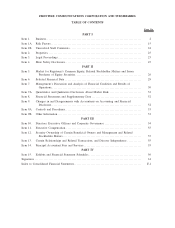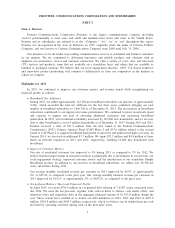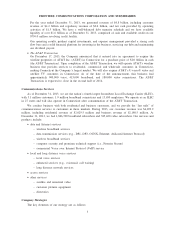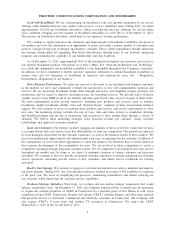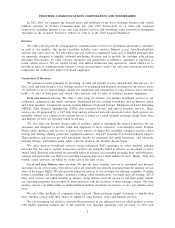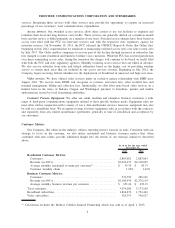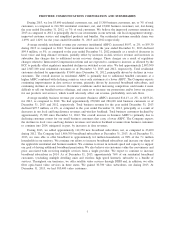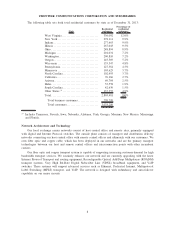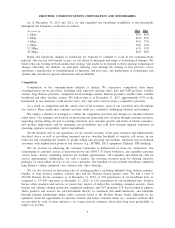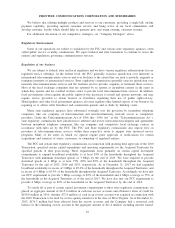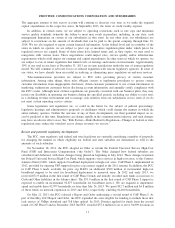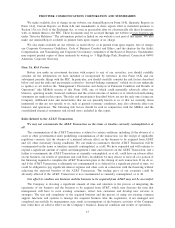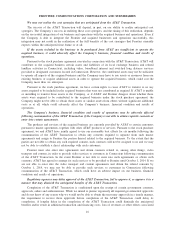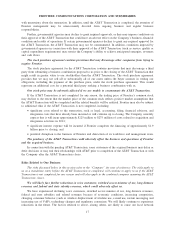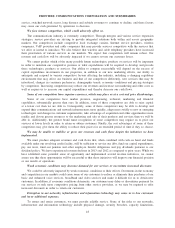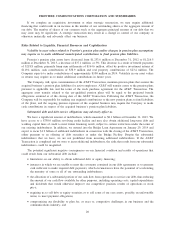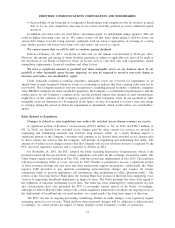Frontier Communications 2013 Annual Report Download - page 12
Download and view the complete annual report
Please find page 12 of the 2013 Frontier Communications annual report below. You can navigate through the pages in the report by either clicking on the pages listed below, or by using the keyword search tool below to find specific information within the annual report.The aggregate amount of this escrow account will continue to decrease over time as we make the required
capital expenditures in the respective states. In September 2013, the letter of credit facility expired.
In addition, in certain states, we are subject to operating restrictions such as rate caps and minimum
service quality standards (whereby the failure to meet may result in penalties, including, in one state, cash
management limitations on certain of our subsidiaries in that state). In one other state, our subsidiaries are
subject to restrictions on the amount of dividends that can be paid to the parent company through June 30,
2014. We are also required to report certain financial information. At the federal level and in a number of the
states in which we operate, we are subject to price cap or incentive regulation plans under which prices for
regulated services are capped. Some of these plans have limited terms and, as they expire, we may need to
renegotiate with various states. These negotiations could impact rates, service quality and/or infrastructure
requirements which could impact our earnings and capital expenditures. In other states in which we operate, we
are subject to rate of return regulation that limits levels of earnings and returns on investments. Approximately
19% of our total access lines at December 31, 2013 are in state jurisdictions under the rate of return regulatory
model. We will continue to advocate for no or reduced regulation with various regulatory agencies. In some of
our states, we have already been successful in reducing or eliminating price regulation on end-user services.
Telecommunications providers are subject to FCC rules governing privacy of certain customer
information. Among other things, these rules obligate carriers to implement procedures to: protect certain
customer information from inappropriate disclosure; obtain customer permission to use certain information in
marketing; authenticate customers before disclosing account information; and annually certify compliance with
the FCC’s rules. Although most of these regulations are generally consistent with our business plans, they may
restrict our flexibility in operating our business during the specified periods, including our ability to raise rates
in a declining revenue environment and to manage cash transfers from our subsidiaries in two states if we do
not meet certain operating service criteria.
Some legislation and regulations are, or could in the future be, the subject of judicial proceedings,
legislative hearings and administrative proposals or challenges which could change the manner in which the
entire industry operates. Neither the outcome of any of these developments, nor their potential impact on us,
can be predicted at this time. Regulation can change rapidly in the communications industry, and such changes
may have an adverse effect on us. See “Risk Factors—Risks Related to Regulation—Changes in federal or state
regulations may reduce the switched access charge revenues we receive.”
Recent and potential regulatory developments
The FCC, state regulators, and federal and state legislators are currently considering a number of proposals
for changing the manner in which eligibility for federal and state subsidies are determined as well as the
amounts of such subsidies.
On November 18, 2011, the FCC adopted an Order to reform the Federal Universal Service High-Cost
Fund (USF) and Intercarrier Compensation (“the Order”). The Order changed how federal subsidies are
calculated and disbursed, with these changes being phased-in beginning in July 2012. These changes transition
the Federal Universal Service High-Cost Fund, which supports voice services in high-cost areas, to the Connect
America Fund (CAF), which supports broadband deployment in high-cost areas. CAF Phase I, implemented in
2012, provided for ongoing USF support for price cap carriers capped at the 2011 amount. In addition, the FCC
in CAF Phase I made available for price cap ILECs an additional $300 million in incremental high-cost
broadband support to be used for broadband deployment to unserved areas. In 2012 and early 2013, we
received $71.9 million in the first round of CAF Phase I funds and initially recorded such funds as increases to
Cash and Other liabilities in the balance sheet. The $71.9 million in the first round of CAF Phase I support is
expected to enable an incremental 92,877 households for broadband service. We are required to implement,
spend and enable these 92,877 households no later than July 24, 2015. We spent $32.7 million and $4.8 million
of these funds on network expansion in 2013 and 2012, respectively, enabling 64,400 households.
On May 21, 2013, the FCC released a Report and Order authorizing a second round of CAF Phase I. As
part of this May 2013 Report and Order, the FCC expanded the areas eligible for funding to include those that
lack service of 3Mbps download and 768 kbps upload. In 2013, Frontier applied for funds from the second
round of CAF Phase I and in December 2013 the FCC awarded $57.6 million to us to serve 94,899 locations in
11
FRONTIER COMMUNICATIONS CORPORATION AND SUBSIDIARIES


